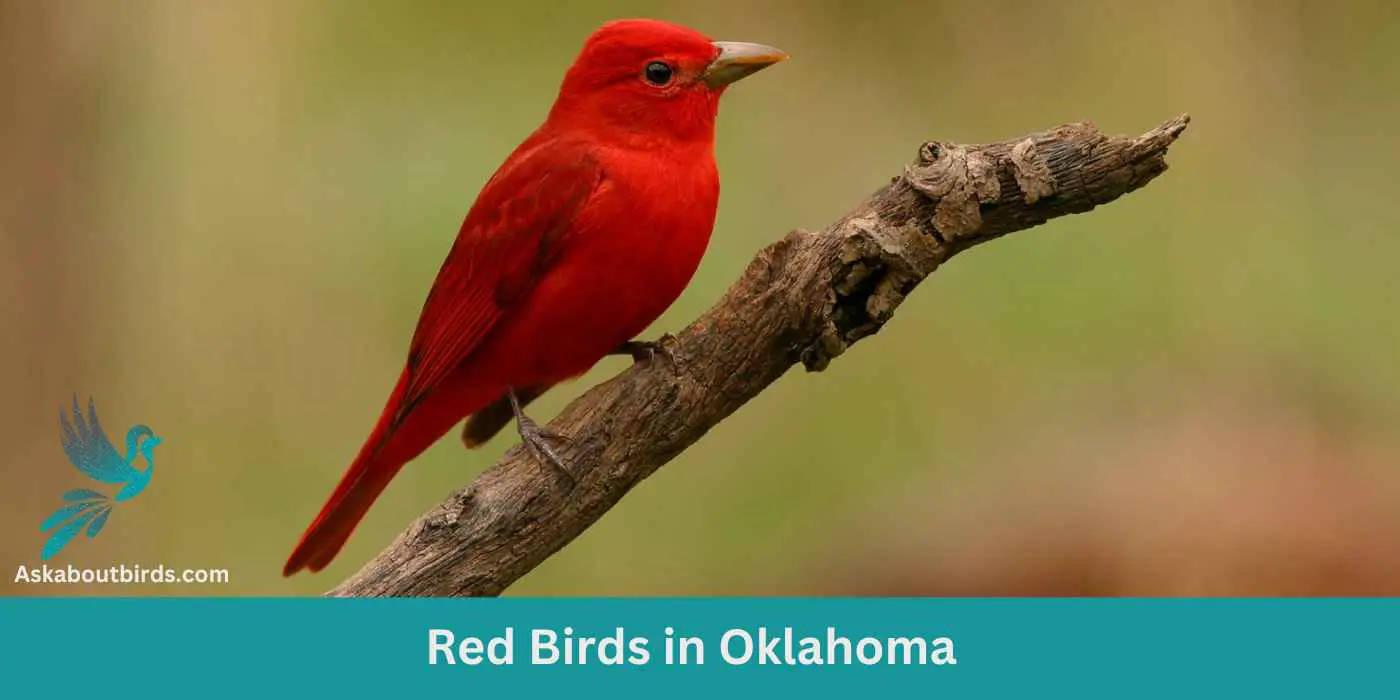Oklahoma, with its diverse landscapes ranging from plains to forests, provides a haven for a multitude of bird species. Among its winged residents, the state is particularly adorned by a collection of striking red birds.
These avian beauties not only embellish Oklahoma’s skies but also captivate bird enthusiasts and photographers alike.
Join us in exploring the 14 radiant red birds in Oklahoma and let our free photo guide be your visual companion on this feathery journey.
Red Birds Found In Oklahoma
In the heart of the U.S., Oklahoma is a geographical nexus where eastern woodlands meet western plains, southern swamps brush against northern temperate forests. This unique confluence of ecosystems results in a rich tapestry of habitats.
As such, the state becomes a gathering spot for a variety of avian species seeking nesting grounds, migratory stopovers, or year-round homes.
Northern Cardinal


| Feature | Measurement |
|---|---|
| Scientific Name | Cardinalis cardinalis |
| Length | 8.3 – 9.1 in |
| Wingspan | 9.8 – 12.2 in |
| Weight | 1.19 – 2.29 oz |
The Northern Cardinal is an iconic North American bird, easily recognized by its vibrant color and melodious song.
Appearance: Male Northern Cardinals are a brilliant scarlet red, while females display a more subdued reddish olive. Both sexes have a distinctive black ‘mask’ on their face around the bill and a pointed crest on their head. The bird’s beak is robust, cone-shaped, and bright orange in color.
Diet: Northern Cardinals are primarily granivorous, with a diet largely consisting of seeds and grains. They also eat fruits and insects. These birds typically feed off the ground and are frequent visitors to bird feeders.
Reproduction: Northern Cardinals are monogamous, and a pair will breed together for life. The female typically builds a well-hidden nest in a dense thicket or shrub. She lays 2-5 eggs per clutch, which she incubates for around two weeks.
Summer Tanager


| Feature | Measurement |
|---|---|
| Scientific Name | Piranga rubra |
| Length | 6.7 in |
| Wingspan | 28 to 30 cm |
| Weight | 29 g |
The Summer Tanager is a medium-sized songbird admired for its radiant plumage and melodious song.
Appearance: Male Summer Tanagers are an impressive bright red, while females and juveniles present a softer, yellow-orange color. Both genders have a large, slightly hooked bill and relatively short tail.
Diet: Summer Tanagers primarily feed on insects, including bees and wasps, which they catch in flight or pick off vegetation. They are also known to eat fruits and berries, making them helpful in controlling pest populations and seed dispersal.
Reproduction: The female Summer Tanager builds a loose, shallow cup-shaped nest out of twigs and grass, usually hidden in the foliage of trees. The female typically lays 3-5 eggs, which she will incubate for about two weeks.
Scarlet Tanager


| Feature | Measurement |
|---|---|
| Scientific Name | Piranga olivacea |
| Length | 6.3 to 7.5 in |
| Wingspan | 9.8 to 11.8 in |
| Weight | 23.5 to 38 g |
The Scarlet Tanager is a strikingly colorful bird known for its brilliant plumage and distinctive song.
Appearance: Male Scarlet Tanagers are notable for their vibrant scarlet bodies contrasted with black wings and tail, making them one of the most intensely colored birds. Females and juveniles, on the other hand, have a subdued olive-yellow body color with darker wings and tail.
Diet: The diet of the Scarlet Tanager is largely made up of insects, including beetles, cicadas, aphids, and others. They are adept flycatchers, seizing insects in mid-air or picking them off foliage. They also consume fruits and berries, especially during migration and in their winter habitats.
Reproduction: The female Scarlet Tanager builds a cup-shaped nest using twigs, rootlets, and grass, typically well-hidden in the dense foliage of trees. She lays 3 to 5 eggs and incubates them for about two weeks.
Vermilion Flycatcher
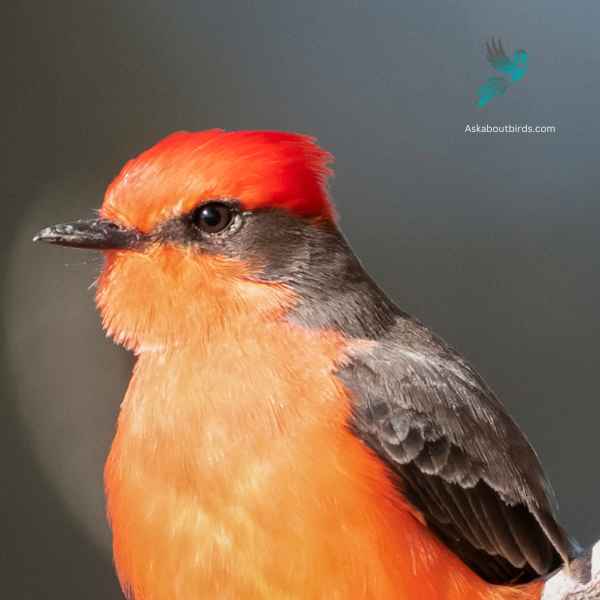

| Feature | Measurement |
|---|---|
| Scientific Name | Pyrocephalus obscurus |
| Length | 5.1–5.5 in |
| Wingspan | 9.4 to 9.8 in |
| Weight | 11 to 14 g |
The Vermilion Flycatcher is a small and colorful bird native to the Americas. The male Vermilion Flycatcher is a striking sight, displaying a vibrant red plumage on its head, breast, and underparts, contrasting with its brown wings and black tail below. Females, on the other hand, have more muted colors, featuring a pale yellowish belly and grayish-brown upperparts.
Vermilion Flycatchers are known for their lively and acrobatic flight displays, which they perform during courtship or to defend their territories. They often sing a series of soft, whistled notes while engaged in these aerial displays. They construct cup-shaped nests, usually in shrubs or low trees, where females lay their eggs and raise their young.
Red-bellied Woodpecker
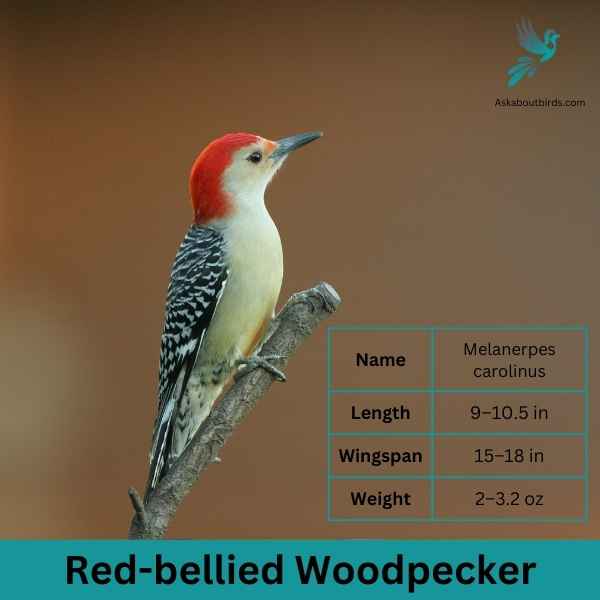
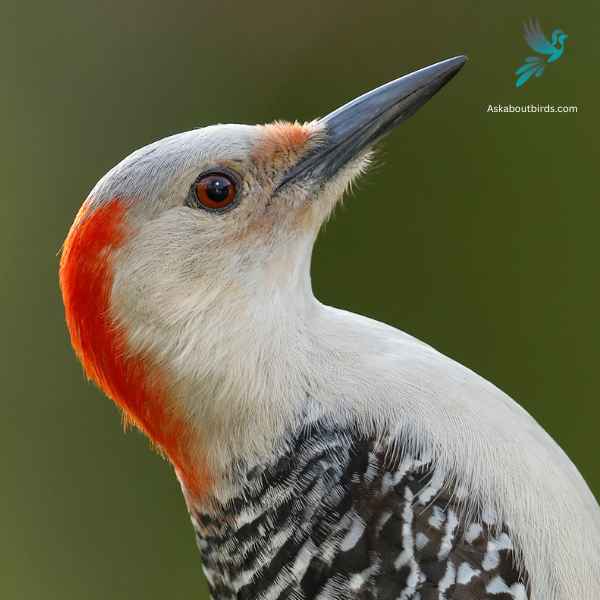
| Feature | Measurement |
|---|---|
| Scientific Name | Thryothorus ludovicianus |
| Length | 4.7–5.5 in |
| Wingspan | 11 in |
| Weight | 0.63–0.81 oz |
The Red-bellied Woodpecker is a medium-sized woodpecker commonly found in woodlands, forests, and backyards across the eastern and central U.S.
Appearance: The Red-bellied Woodpecker sports a pale gray face, throat, and belly, contrasted by a zebra-striped back. Its name derives from the subtle reddish tinge on its belly, but it’s more commonly recognized by the vivid red cap on the head of males and the partial red cap on females.
Diet: This woodpecker has a varied diet that includes insects, fruits, nuts, and seeds. They frequently forage on tree trunks and branches, using their sticky, barbed-tipped tongue to extract ants, beetles, and other insects from crevices.
Reproduction: Red-bellied Woodpeckers are cavity nesters, excavating holes in tree trunks for their nests. The inside of the nest is typically unlined or sparingly lined with wood chips.
Red-headed Woodpecker

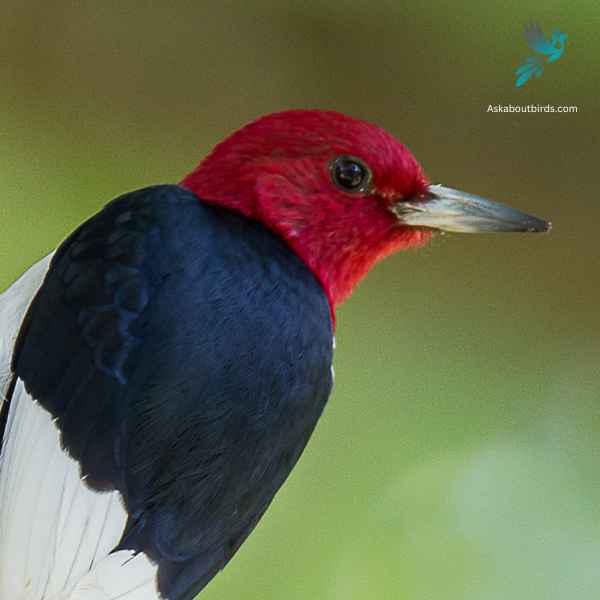
| Feature | Measurement |
|---|---|
| Scientific Name | Melanerpes erythrocephalus |
| Length | 7.5–9.1 in |
| Wingspan | 16.5 in |
| Weight | 2.0–3.2 oz |
The Red-headed Woodpecker is a striking forest bird with a bold tri-colored pattern.
Appearance: This woodpecker features a completely red head and neck, contrasting starkly with its white underparts and black wings. Its wings also have large white patches which are conspicuous in flight.
Diet: Red-headed Woodpeckers have a varied diet including insects, seeds, fruits, berries, and occasionally even the eggs of other birds. They’re also known to store food by wedging it into crevices in bark.
Reproduction: These woodpeckers nest in cavities which they excavate in dead wood or dead parts of live trees. These cavities can be found anywhere from 2 to 80 feet off the ground.
Rose-breasted Grosbeak
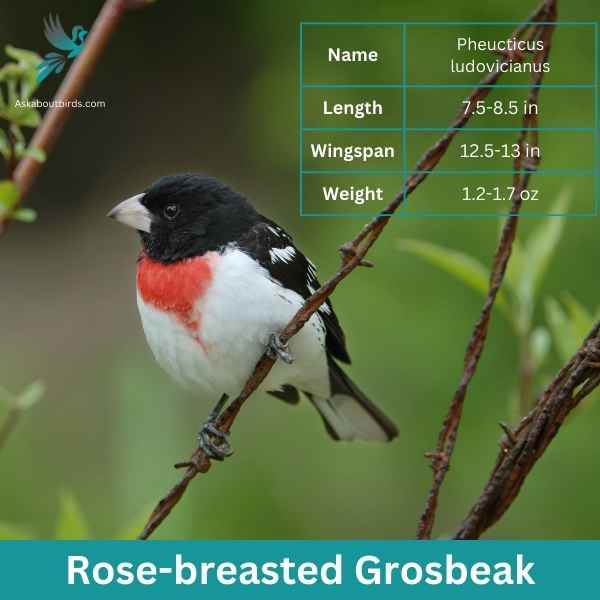

| Feature | Measurement |
|---|---|
| Scientific Name | Pheucticus ludovicianus |
| Length | 7.5-8.5 in |
| Wingspan | 12.5-13 in |
| Weight | 1.2-1.7 oz |
The Rose-breasted Grosbeak is a songbird of medium size, widely recognized for its vibrant coloration and melodious song.
Appearance: Male Rose-breasted Grosbeaks boast a striking contrast with black and white plumage accompanied by a radiant rose-colored patch on the chest and under the wings. In contrast, females exhibit streaked brown and white plumage, resembling large sparrows but with a thick bill.
Diet: The diet of the Rose-breasted Grosbeak consists of a mixture of seeds, insects, and fruits. During summer, they primarily feed on insects, while seeds and fruits become more prevalent in their diet during the colder months.
Reproduction: These birds build cup-shaped nests typically situated in trees or large shrubs. Both the male and female partake in incubation duties, ensuring the eggs’ safety and warmth. After hatching, the chicks are primarily fed insects.
House Finch


| Feature | Measurement |
|---|---|
| Scientific Name | Haemorhous mexicanus |
| Length | 5–6 in |
| Wingspan | 8–10 in |
| Weight | 0.6–0.9 oz |
The House Finch is a small songbird widely distributed across North America and is commonly found in urban and suburban areas.
Appearance: Males of this species are brightly colored with crimson faces and throats, which can extend to the chest and back, while their flanks have streaks. The female is streaked brown and lacks the red coloring. Both have a square-tipped tail and a distinctively long, flat-topped bill.
Diet: House Finches primarily eat seeds, grains, and berries. They have a particular fondness for sunflower seeds and can be commonly seen at bird feeders. Occasionally, they will also consume insects, especially during the breeding season.
Reproduction: House Finches are cavity-nesters and might choose ledges, vents, ledges, and other urban settings. They might also utilize trees or shrubs. Their nests can be made of a wide array of materials, from feathers to twigs.
Pine Grosbeak

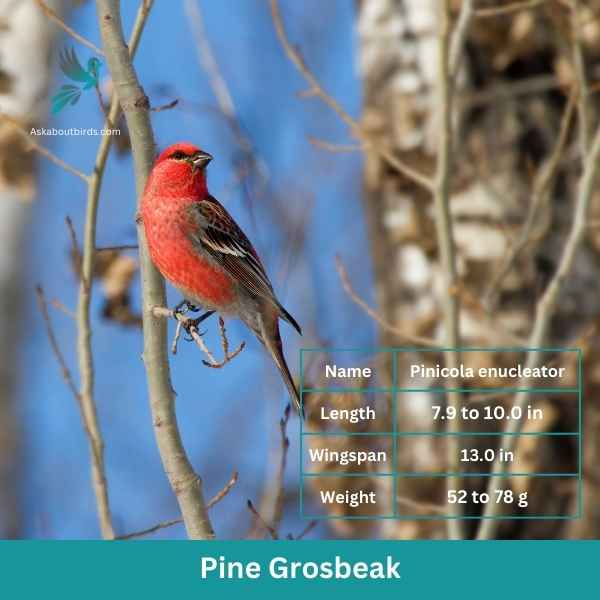
| Feature | Measurement |
|---|---|
| Scientific Name | Pinicola enucleator |
| Length | 7.9 to 10.0 in |
| Wingspan | 13.0 in |
| Weight | 52 to 78 g |
The Pine Grosbeak is a striking bird native to the northern regions of North America, often found in coniferous forests. Both males and females have a plump and robust body with a large beak adapted for eating seeds. The male Pine Grosbeak displays a vibrant reddish-pink plumage, while the female has a more subdued grayish-brown coloration.
These birds are typically seen in small flocks, foraging for food in trees and on the ground. They have a preference for seeds, particularly those from various conifer species. The Pine Grosbeak uses its strong bill to crack open the cones of tall trees and extract the seeds, but they also consume berries and small fruits when available.
Purple Finch


| Feature | Measurement |
|---|---|
| Scientific Name | Haemorhous purpureus |
| Length | 4.7–6.3 in |
| Wingspan | 4.7–6.3 in |
| Weight | 0.6–1.1 oz |
The Purple Finch is a vibrant songbird often mistaken for its close relative, the House Finch, but it exhibits a different hue and patterns.
Appearance: Males are raspberry red on the head, throat, and breast, with streaky brown backs and wings. The intensity of the red can vary among individuals. Females are brown and streaked all over but might show a slight blush on the face. They lack the strong facial patterns seen in female House Finches.
Diet: Purple Finches primarily consume seeds, with a preference for sunflower seeds, dandelion seeds, and buds. They also eat insects and berries, especially during the breeding season.
Reproduction: These finches often nest in conifers or mixed woodlands. The nest, typically located on a horizontal branch, is made from twigs and grass, then lined with feathers.
Red Crossbill

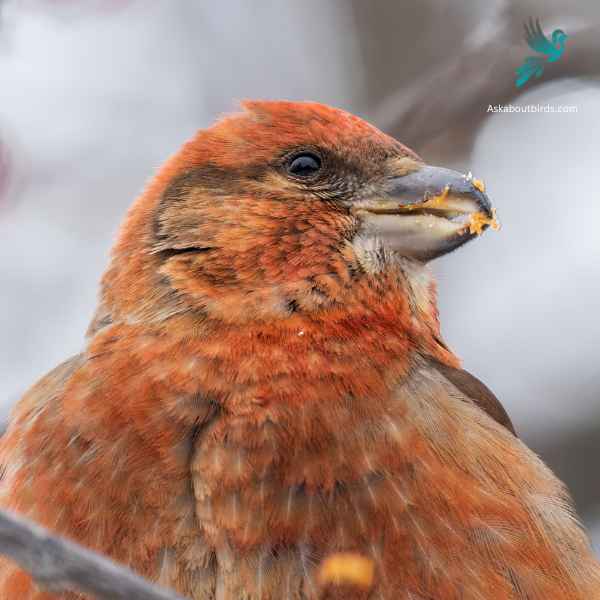
| Feature | Measurement |
|---|---|
| Scientific Name | Loxia curvirostra |
| Length | 5.5–7.5 in |
| Wingspan | 9.8–10.6 in |
| Weight | 0.9–1.4 oz |
The Red Crossbill is a distinctive finch known for its unusual bill, which has evolved to extract seeds from conifer cones.
Appearance: Males are typically bright red or orange, while females are greenish-yellow or olive. Both genders have the characteristic crossed bill, which they use to expertly extract seeds from tightly closed conifer cones.
Diet: Red Crossbills primarily feed on the seeds of coniferous trees, such as spruce, pine, and fir. Their specialized bills allow them to efficiently pry apart conifer cone scales to access the seeds.
Reproduction: Red Crossbills are somewhat nomadic and don’t adhere to a strict breeding schedule. Instead, they breed whenever and wherever food is abundant. Their nests are usually built on horizontal branches of conifer trees.
Common Redpoll

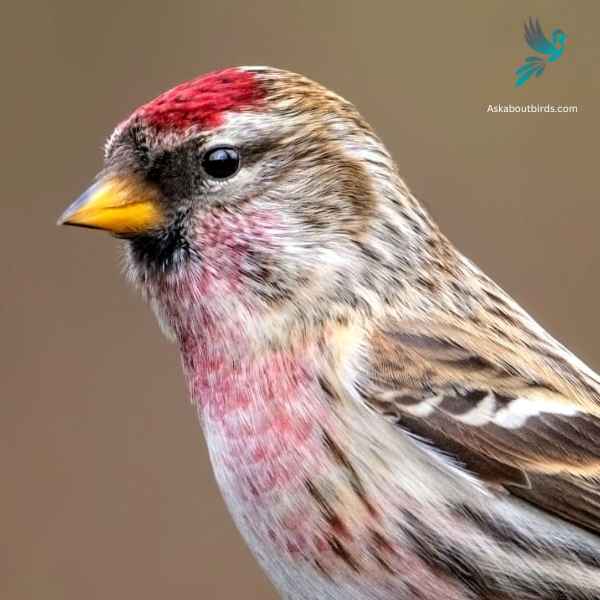
| Feature | Measurement |
|---|---|
| Scientific Name | Acanthis flammea |
| Length | 5.0-5.5 in |
| Wingspan | 7.5-8.5 in |
| Weight | 0.4-0.9 oz |
The Common Redpoll is a small songbird that is easily identifiable by its rosy-red forehead, black chin, and often fluttering flight pattern.
Appearance: Common Redpolls exhibit a distinctive rosy-red forehead patch and black chin. The males typically have a more extensive pink wash on their chest and face than females. The rest of their body is primarily streaked brown and white, with two white wing bars and a notched tail.
Diet: The diet of the Common Redpoll predominantly consists of seeds, particularly from birches and alders. They have a specialized throat pouch where they can temporarily store seeds, allowing them to consume them later in a more sheltered location.
Reproduction: Common Redpolls nest in shrubs or on the ground, using grasses, twigs, and feathers for construction. The female is responsible for the majority of the incubation and typically lays a clutch of 4 to 6 eggs. After the eggs hatch, both parents take part in feeding the young.
Painted Bunting
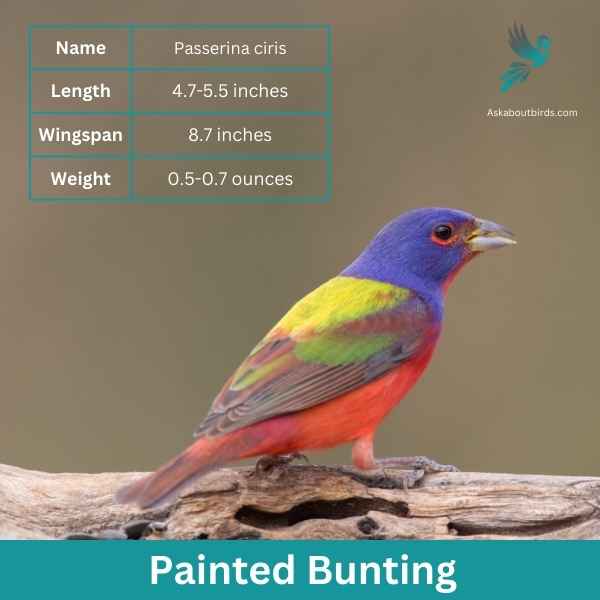
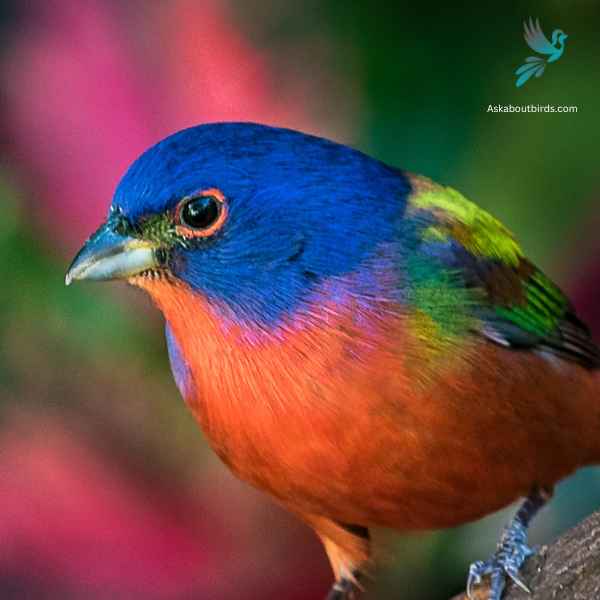
| Feature | Measurement |
|---|---|
| Scientific Name | Passerina ciris |
| Length | 4.7-5.5 inches |
| Wingspan | 8.7 inches |
| Weight | 0.5-0.7 ounces |
The Painted Bunting is often regarded as one of North America’s most dazzling songbirds, attracting birdwatchers and nature enthusiasts with its vibrant colors.
Appearance: Male Painted Buntings boast a breathtaking blend of colors: a bright blue head, red underparts, and green back. Females and juveniles, however, sport a more uniform green-yellow plumage. Despite the male’s eye-catching appearance, these birds can be elusive, often preferring to stay hidden in shrubs and thickets.
Diet: These birds are primarily seed eaters, favoring seeds of native grasses. They also consume insects, especially during the breeding season, which provides the necessary protein for their young.
Reproduction: Painted Buntings often nest in dense cover, usually in shrubs or trees. The female selects the nesting site and constructs the nest, which is typically a cup-shaped structure made of grasses and spiderwebs.
American Robins


| Feature | Measurement |
|---|---|
| Scientific Name | Leptotila plumbeicep |
| Length | 10.6-11.8 in |
| Wingspan | — |
| Weight | 160-200 g |
The American Robin is a widely recognized bird species known for its melodious song and early bird tendencies.
Appearance: American Robins are medium-sized birds with a distinctive appearance. Both males and females sport a gray to brown back and a warm red to orange breast and belly and gray wings. They also have a characteristic white eye-ring and a black head, but males are usually darker than females.
Diet: American Robins have a diverse diet that changes depending on the season. In summer, they feed heavily on earthworms, beetles, and other invertebrates, which they catch on the ground. During winter, they mostly eat fruits and berries.
Reproduction: American Robins usually build their nests in trees or shrubs, but they are also known to nest on human-made structures. The female lays a clutch of about 3 to 5 eggs, which she incubates for about 12 to 14 days.
Where to Spot Oklahoma’s Red Birds
Discover the best of Oklahoma’s avian wonders in these birding hotspots, known for their impressive diversity and red bird sightings:
- Wichita Mountains Wildlife Refuge: Located in southwestern Oklahoma, this refuge boasts rugged landscapes and a plethora of bird species, including the vibrant Painted Bunting. It’s a haven for bird enthusiasts year-round.
- Oxley Nature Center, Tulsa: Nestled within Mohawk Park, the Oxley Nature Center offers diverse habitats, from wetlands to forests. It’s a prime location for spotting a variety of songbirds, especially during migration seasons.
- Salt Plains National Wildlife Refuge: As one of the most unique places in Oklahoma, these salt flats attract various shorebirds and waterfowl. The contrasting landscapes here make it an ideal place for bird photography.
- Red Slough Wildlife Management Area: Located in southeastern Oklahoma, this wetland habitat draws a wide variety of water birds, including waders, ducks, and the occasional rare visitor, making it a must-visit for avid birders.
- Black Mesa State Park & Nature Preserve: Situated in the panhandle, Black Mesa offers a unique combination of desert and mountain birds. Here, you might catch a glimpse of the elusive Scott’s Oriole or the vibrant Summer Tanager.
| State’s Red Birds | Best Spots for Red Birds |
|---|---|
| Texas’s Red birds | 1. High Island 2. Laguna Atascosa National Wildlife Refuge 3. South Padre Island |
| Arkansas’s Red birds | 1. Hot Springs National Park 2. Holla Bend National Wildlife Refuge 3. Mount Magazine State Park |
| Kansas’s Red birds | 1. Cheyenne Bottoms Wildlife Area 2. Quivira National Wildlife Refuge 3. Flint Hills |
| Missouri’s Red birds | 1. Mingo National Wildlife Refuge 2. Mark Twain National Forest 3. Eagle Bluffs Conservation Area |
| Colorado’s Red birds | 1. Rocky Mountain National Park 2. Barr Lake State Park 3. Pawnee National Grassland |
| New Mexico’s Red birds | 1. Bosque del Apache National Wildlife Refuge 2. Rattlesnake Springs 3. Valle de Oro National Wildlife Refuge |
FAQs on Red Bird Species Found in Oklahoma
What attracts bright red birds to backyard bird feeders?
Bright red birds, known for their striking red plumage, often flock to backyard bird feeders filled with black oil sunflower seeds. These vibrant birds, especially the ones native to northern and western states, are particularly attracted to these seeds, which provide essential nutrients. Forest edges and oak woodlands are common habitats, but backyard feeders provide an easy and convenient food source. Feeders positioned in the forest canopy or dense vegetation often see higher visits from these red-feathered species, making them a delightful addition to any backyard.
How do certain bird species adapt to forest edges and canopy in Central and South America?
In the diverse ecosystems of Central and South America, many bird species have adapted to life at forest edges and within the forest canopy. Medium-sized birds with brown plumage often camouflage seamlessly in this habitat, using the dense vegetation to protect themselves from predators. Species with green wings and yellow feathers blend in with the foliage, using their tail feathers for agility amidst the trees. While some are accidental or rare species, making occasional appearances, others, like the white-winged crossbills, often form large flocks, feeding on conifer seeds and thriving in these unique environments.
Why are black oil sunflower seeds popular in backyard feeders across southern and eastern states?
Black oil sunflower seeds are immensely popular in backyard feeders, especially in the southern and eastern states, primarily because they appeal to a vast array of bird species, including those with vibrant red plumage. These seeds are not only nutritious but also have a high-fat content, providing birds with the energy they need. Moreover, their thin shells make them easily accessible to even smaller bird species. Along with the attraction of these seeds, backyard feeders placed near dense vegetation or forest edges often see a surge in avian visitors, enhancing the bird-watching experience for many enthusiasts.

